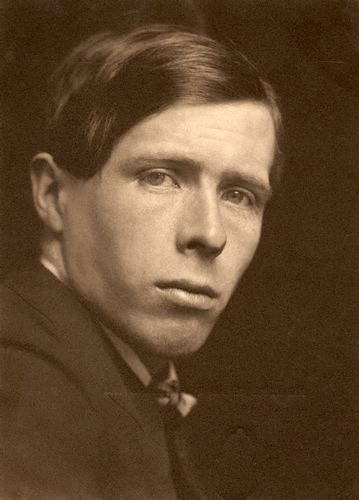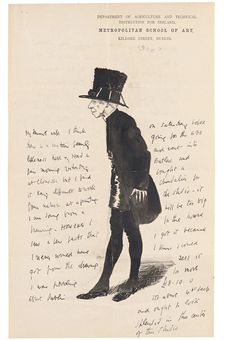The Blue Hat - Portrait of Vera Hone from The Angler Series - 1912
Self-Portrait 1907
The Man From Arran - self-portrait 1918
The Jockey - (Looks like another self-portrait to me, though it isn't listed as such.)
Portrait of the painter, Augustus John - 1900
In Dublin Bay - 1909
The Eastern Gown
The Mirror - 1900
Portrait of Gertrude Sandford Legendre
Bridgit - A Picture of Miss Elvery (Glenavy) 1909
Portrait of Herbert Bernard John Everett
The Thinker - On the Butte de Warlencourt
Zonnebeke - 1918
The NCO Pilot - W.G. Bennett
An Airman - Lieut. RTC Hoidge
To An Unknown Soldier
Sir William Orpen (1878 - 1931) was an Irish painter born in Dublin. He lived and painted in England and became a famed war artist during WWI. Though he was well known during his lifetime and painted many portraits of the well to do, politicos and such i.e. President Woodrow Wilson, time wasn't kind to Orpen and he and his work virtually disappeared from collective memory in the years since his death at the age of 53.
I admit I'd never heard of him until I stumbled across a painting of his online while looking for something else. Orpen's work hangs in various museums, especially The Imperial War Museum in London, but his place in art history is apparently overdue a re-evaluation. (Prices for his work have recently increased and that usually means re-evaluation is currently underway.)
In 1917, Orpen was commissioned and sent to the Western Front to paint what he saw, along with several other painters of talent and renown, i.e. Sir John Lavery. Many of these paintings offer a grim account of life in the wretched trenches, the price of war, especially on the 'common' soldier. Orpen grew to despise the generals in command though forced to work for them as a main source of commissions.
In later years alcohol and ill health (due to his war exploits), helped curtail his life.
Sir William Orpen
I was taken with Orpen's work, quite moved by some of it. I hope you will be as well.
To learn about Sir William Orpen and his work, please check this link and also this one.
In 1909 Orpen painted a wonderful portrait of his friend and former pupil, Bridgit Glenavy nee Elvery, with whom he continued to exchange letters for many years until their final falling out.
Many of the letters that Orpen exchanged with his friends were peppered with sketches and comments. Below are some examples:
Disclaimer: I do not own any of the images included in today's post not do I claim to have the rights to any of the artwork. I have garnered these images from various sources on the internet strictly for purposes of education and historic and artistic enlightenment.












.jpg)











Yvette: Canada has had artists with our military from WW I to their deployment in Afghanistan that ended last year. I have seen exhibitions in Ottawa and at the McMichael Gallery in Kleinburg, Ontario. They offer a powerful perspective on war that is unique from photos.
ReplyDeleteYvette, "The man from Arran", "The Thinker", "The NCO pilot" and "The airman" are exceptional paintings. Such fine artistry amidst the horror of war.
ReplyDeleteHi, Yvette - I became familiar with Orpen while reading histories of WWI, and I think his recording of the signing of the Versailles Peace Treaty is still probably his most recognizable work. But his portraits are my favorites — they have a rich style that no one would mistake as anything but his own. To see one in person is a real treat. He worked with rich blocks of color and often used a brush as though it were a palette knife. Looking at work like that first self-portrait, one can appreciate that the man understood light.
ReplyDeleteI LOVE that blue hat - in fact, I pinned it on my Things of Beauty board.
ReplyDeleteThanks for the intro to Orpen!
Bill, I think every country that has ever been to war has had artists on the front lines. Even after photography was invented. I wasn't looking to focus on war art. I just happened upon Orpen's work and since that was a good part of his painting life, I included it.
ReplyDeletePowerful perspective is right. We need photos, but we also need the artist who will witness with paint and canvas or pen and pencil.
I agree, Prashant. I wonder how these artists could keep their senses and their creative spirit while guns were blazing around them.
ReplyDeleteUnfortunately, I think many of them turned to alcohol or whatnot.
I won't disagree, Mark. The man was a fabulous painter. I would, indeed, love to see his work in person. The Met only has a couple of them, but I think the self-portrait you indicated is one of them.
ReplyDeleteYou know the story of the Tomb of the Unknown Soldier painting I'm showing on the post? There are two figures he had to paint out because of protests from the head honchos.
Interesting story.
Debbie, isn't that a wonderful painting? That hat is marvelous. As is the look in the sitter's eyes.
ReplyDeleteYvette...the Jockey painting is indeed an Orpen self-portrait. The original oil painting was sold, by Orpen, to the National Museum in Stockholm. I'm fortunate to own one of Orpen's preliminary/preparatory oil studies of the same portrait.
ReplyDeleteADG: Wow, fortunate, indeed. I was unfamiliar with Orpen's work until very recently. He really was a marvelous artist.
ReplyDeleteI do wonder about all the self-portraits though. I can only imagine he found himself fascinating. And why not?
Or maybe he just liked to play dress-up.
There's something very sinister about the jockey portrait...
where is the portrait of the jockey?
ReplyDelete